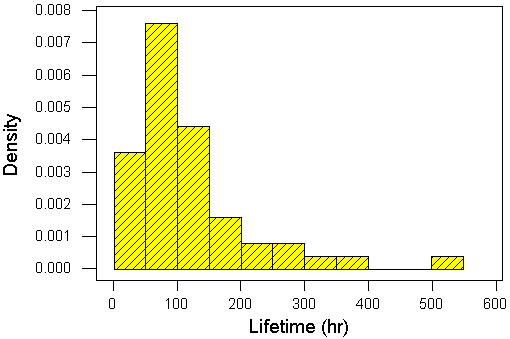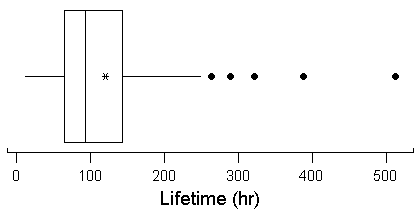The actual time, in hours, to failure of a prototype mechanical component in a turbine, is measured on fifty occasions in an experiment. The raw results are displayed here, sorted into increasing order:
| 11 | 14 | 20 | 23 | 31 | 36 | 39 | 44 | 47 | 50 |
| 59 | 61 | 65 | 67 | 68 | 71 | 74 | 76 | 78 | 79 |
| 81 | 84 | 85 | 89 | 91 | 93 | 96 | 99 | 101 | 104 |
| 105 | 105 | 112 | 118 | 123 | 136 | 139 | 141 | 148 | 158 |
| 161 | 168 | 184 | 206 | 248 | 263 | 289 | 322 | 388 | 513 |
The summary statistics include
![]()
- From the summary statistics, calculate the sample mean
and sample standard deviation for these data.

- From the histogram below, identify the modal class.

The modal class has the bar with the greatest area.
With all class widths equal, that is also the tallest bar.
Obviously, the modal class is
[50, 100) hours - What evidence is there, from the histogram, for skewness?
The right tail is considerably thicker and longer than the left tail.
There is strong evidence for a substantial positive skew. - Use the histogram only, to estimate the number of components
in the sample, whose lifetimes are less than 50 hours.
Lifetimes less than 50 hours are represented by the first class (and therefore the first bar) in the histogram.
Relative frequency = area of bar = (width) × (height) .
The width of the bar is 50 hours.
The height seems to be between 0.0036/hr and 0.0037/hr.
The relative frequency is therefore between 18% and 18.5%.
The frequency = (relative frequency) × n = (between 18% and 18.5%)×50 = 9 to 9.25 .
But the frequency must be a whole number. Therefore
n(T < 50 hours) = 9 - A stem-and-leaf diagram for these data is
9 0 112233344 (19) 0 5566667777788889999 22 1 00001123344 11 1 5668 7 2 04 5 2 68 3 3 2 2 3 8 1 4 1 4 1 5 1Use this stem-and-leaf diagram to construct a frequency (and cumulative frequency) table and hence find the median class.
Lifetime Frequency Cum. Freq. [0, 50) 9 9 [50, 100) 19 28 [100, 150) 11 39 [150, 100) 4 43 [200, 250) 2 45 [250, 300) 2 47 [300, 350) 1 48 [350, 400) 1 49 [400, 450) 0 49 [450, 500) 0 49 [500, 550) 1 50
The median class is where the 25th and 26th values fall, which is clearly the class[50, 100) .
[In a stem-and-leaf diagram, the median class is very easy to find. Seek the row where the cumulative frequency in the first column is replaced by a frequency in brackets, in this case(19).] - Find the median value from the original data.
From the stem-and-leaf diagram, one can identify the 25th and 26th values as being between 90 and 99 inclusive. From the raw data, the median is(91 + 93) / 2 = 92. - The asterisk in the boxplot below denotes the location of the
sample mean.
Describe the evidence for skewness that you can see in the boxplot.

All of the following provide very strong evidence for a substantial positive skew in the data:
- The right whisker is much longer than the left whisker.
- The upper quartile is much further away from the median than the lower quartile.
- The mean is greater than the median.
- There are five outliers, all greater than the median.
- List all the outliers.
The outliers are the five largest values in the data set.
They are
263, 289, 322, 388, 513
[The upper outer fence is at
(upper quartile) + 3×(inter-quartile range) = 142.75 + 3×78.75 = 379.]

![Circuit A to R1 to
[parallel: (series {parallel R2, R4}, R5), R3] to B](t1images/t1pq7relay.gif)
![P[D|T] = P[T|D] P[D] / P[T]](t1images/q9bayes1.gif)
![[tree diagram]](t1images/q9tree.gif)